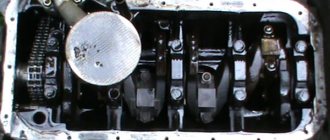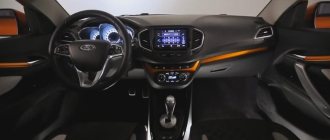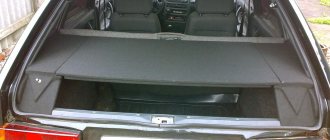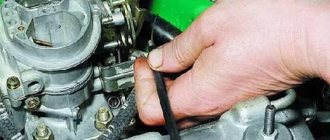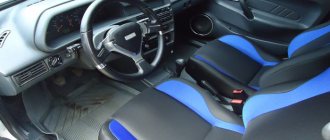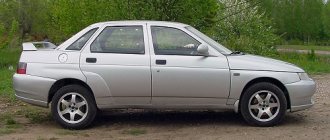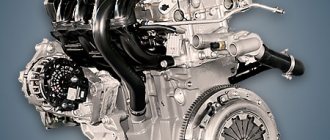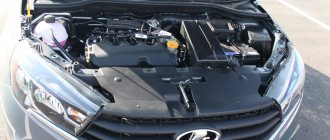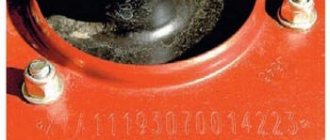Specifications
Motor characteristics:
| See all advertisements in the archive |
| PARAMETER | MEANING |
| Years of manufacture | 1994 – present |
| Engine weight, kg | 124 |
| Cylinder block material | cast iron |
| Supply system | injector |
| Type | in-line |
| Engine displacement | 1.5 |
| Power | 78 horsepower at 5400 rpm |
| Number of cylinders | 4 |
| Number of valves per cylinder | 2 |
| Piston stroke, mm | 71 |
| Cylinder diameter, mm | 82 |
| Compression ratio | 9.8 |
| Torque, Nm/rpm | 116 / 3000 |
| Environmental standards | EURO 4 |
| Fuel | AI 93 |
| Fuel consumption | 7.3 l/100 km combined cycle |
| Oil | 5W-30, 15W40 |
| Oil volume | 3.5 |
| When replacing, pour | 3.0 liters |
| Oil change carried out, km | 15 thousand |
| Engine life, thousand km - according to the plant - in practice | 150+ 200+ |
The engine is installed on VAZ: 21083, 2111, 2113, 2114, 2115.
Engine diagram and structure
General view of the engine
Before we begin to consider the issue of the engine design and description of the characteristics, it is necessary to consider the design of the components and parts that are located directly in the main power unit and outside.
Diagram and design of the Samara-2 engine
1 – generator drive pulley; 2 – oil pump; 3 – timing belt; 4 – toothed pulley of the coolant pump; 5 – front cover of the timing mechanism drive; 6 – tension roller; 7 – camshaft toothed pulley; 8 – rear cover of the camshaft drive; 9 – camshaft oil seal; 10 – cylinder head cover; 11 – camshaft; 12 – front cover of camshaft bearings; 13 – pusher; 14 – valve guide; 15 – oil separator mesh for the crankcase ventilation system; 16 – exhaust valve; 17 – inlet valve; 18 – rear cover of camshaft bearings; 19 – fuel pump; 20 – housing of auxiliary units; 21 – ignition distributor sensor; 22 – outlet pipe of the cooling jacket; 23 – cylinder head; 24 – spark plug; 25 – crankcase ventilation hose; 26 – flywheel; 27 – crankshaft rear oil seal holder; 28 – rear crankshaft oil seal; 29 – cylinder block; 30 – oil pan; 31 – oil level indicator (oil dipstick); 32 – crankshaft; 33 – piston; 34 – connecting rod cover; 35 – connecting rod; 36 – crankshaft main bearing cover; 37 – front crankshaft oil seal; 38 – crankshaft toothed pulley.
Also, it’s worth looking at a cross-section of the VAZ-2114 engine:
Cross section of the Samara engine
1 – oil pan drain plug; 2 – oil pan; 3 – oil filter; 4 – coolant pump; 5 – exhaust manifold; 6 – intake manifold; 7 – carburetor; 8 – fuel pump; 9 – cylinder head cover; 10 – camshaft bearing cover; 11 – camshaft; 12 – crankcase ventilation hose; 13 – valve adjusting washer; 14 – pusher; 15 – valve cotters; 16 – valve springs; 17 – oil scraper cap; 18 – valve guide; 19 – valve; 20 – cylinder head; 21 – spark plug; 22 – piston; 23 – compression piston rings; 24 – oil scraper ring; 25 – piston pin; 26 – cylinder block; 27 – connecting rod; 28 – crankshaft; 29 – connecting rod cover; 30 – oil level indicator; 31 – oil pump receiver
Characteristics of an 8-valve engine
Many motorists remember how at the end of the 90s of the 20th century and the beginning of the 2000s, the VAZ 2108-09, which was also called “Samara,” was popular on the roads of the CIS. These cars became legendary in that era. Due to the high popularity, the AvtoVAZ plant decided to resume production of these models with some modifications.
VAZ-2114 engine under the hood
Firstly, the VAZ-2114 received a modified engine . In essence, this is an injection version of the Samara. Although it received some features from modern engines. If we consider in more detail, the Samara-2 engine (this is the type installed on the VAZ-2114) is a mixture of two engine options into one: from the VAZ 2108 and VAZ 2110.
Many motorists liked the Samara-2 power unit and fell in love with it. The main indicator was ease of repair and inexpensive spare parts. Thus, the 8-valve engine has become the standard for “price-quality” indicator.
When the basic information has been reviewed, you can proceed directly to considering the characteristics of the motor.
Table of main characteristics of the Samara-2 engine 8 valves:
| Name | Characteristic |
| engine's type | In-line, longitudinal type, 4-cylinder, 8-valves |
| Fuel type | Gasoline (installation of gas equipment is possible) |
| Cylinder arrangement | 1-4-3-2 |
| Injection system | Distribution, injection type |
| Control | Bosch, "January" or GM |
| Camshaft location | Upper |
| Drive unit | Front |
| Piston and ring diameter | 82 – nominal (tolerances by group: A – 82.00-82.01, B – 82.01-82.02, C – 82.02-82.03, D – 82.03-82.04, E – 82.04-82.05) |
| Crankshaft | Cast iron |
| Cylinder block | Cast iron |
| Timing system | Belt and roller |
Disassembly and repair: basic facts
Let's consider this paragraph of the article as reference information, because if we talk about engine repair, then each individual component and unit is repaired separately. When operating the power unit, it may be necessary to dismantle it. In this case, you can consider replacing the power unit from a foreign car.
Therefore, let’s consider the main operations aimed at removing the engine from the car:
- At the preliminary disassembly stage, it is necessary to drain the oil from the engine, as well as the coolant from the system.
- Another point that should not be missed is turning off the power to the car. This is necessary in order not to short-circuit the system.
- Disconnect the fuel system.
- We dismantle the components that supply air to the engine.
- Disconnect the throttle, as well as all remaining air pipes and cooling system pipes.
- We dismantle the injection system and receiver.
- We remove the ignition system completely.
- Let's disassemble the gas distribution mechanism.
- We remove the thermostat and pump.
- Remove the ignition module.
- Now, you can dismantle the collector.
- Remove the pan, oil filter and pump.
- Disconnect the gearbox and remove the clutch. The gearbox can also be removed for convenience.
- Remove the cylinder head.
- We dismantle the power unit.
- We carry out final disassembly.
Spare parts catalog VAZ-2115
- Body Body 60 Body
- Body panels 21
- Body panels 20
- Body panels 19
- Body floor 14
- Windows 11
- Front frame 4
- Side and rear frame 4
- Trunk lid 18
- Front doors 16
- Rear doors 9
- Tailgate 28
- Front seats 15
- Ventilation and heating system 23
- Interior accessories 14
- Hood 28
- Engine 561 Engine 1
- Fuel tank 45
- Silencers 33
- Radiator 30
- Electronic blocks 19
- Clutch 31 Clutch 12
- Gearbox 27
- Front wheel drive 41
- Differential 24
- Frame, bumpers and engine mudguards 78 Front bumper 14
- Front axle Steering knuckles and hubs 27
- Steering control 107 Steering column 22
- Electrical equipment 1746 Generator (11, 13, 15) 15
- Instruments and lighting 72
- Tools and accessories 5 Driver's tools 5
- Standard parts 292 Studs, bolts, screws 104
- Oil seals 31
- Rolling bearings layout 73
- Plug installation diagram 5
28752c010bd4a6301c533aa9886fda8b
Checking the main relay in a Lada Samara car
In the new car, unlike the previous one, the shape of the hood, rear and front bumpers, a new configuration of the front wings, and improved aerodynamics of the body have changed.
Once you understand it and understand the principle of operation, you can effectively drive your car and perform minor repairs. An on-board computer was also added to the design of the car.
However, in general, the VAZ model remains the same - it is equipped with front-wheel drive and five doors. In practice, our compatriots often encounter problems with the operation of relays - the contact legs of these components can burn out as a result of voltage surges in the electrical network.
Design features A novice car enthusiast is recommended to study the operation of an injection engine. The cabin wiring also has terminal blocks for connecting end consumers. The battery should be periodically recharged from a stationary device. An engine with the same volume, characterized by the presence of a distributor fuel injection system.
More on the topic: Rostechnadzor certificate of registration of an electrical laboratory
Electrical diagram of VAZ 2113, 2114
Brake light bulbs. In the instrument panel wiring harness, the second ends of the white wires are brought together into one point, which is connected to the instrument lighting switch except for the white wire, from plug “4” of block “X2” of the mounting block 28 to the display block 83 of the on-board control system. Windshield washer motor.
Such models are equipped with electronic control systems; they are marked as The second ends of the white wires with a red stripe are brought together to a point connected to plug “10” of the “X4” block of the mounting block. Brake light bulbs. Trip computer or clock.
Why is the VAZ-2110 electrical circuit needed?
It is enough just to maintain it in good condition, and many scheduled maintenance can be carried out with your own hands, using the electrical diagrams of this article as a visual aid. Relay for turning on the heated rear window coil. Disconnect the sensor from the fuel pump. Modifications The manufacturer VAZ offers consumers a choice of several configurations, on which their cost depends: One and a half liter carburetor engine. The pressure level in it should not fall below 3.2 bar.
F8 7.5 A. A motor with the same volume, characterized by the presence of a distributor fuel injection system. Injector relay block So, how is electrical equipment protected on domestic cars: the fuses on the block, which are designed to protect various elements of equipment, are marked as F1-F20; K1 is a device that protects the optical cleaner circuit; K2 - is responsible for the functionality of the light alarm, as well as turn signals; K3 - the element ensures the functionality of the windshield wipers; K4 - the device protects the electrical circuit of optics, in particular, incandescent light bulbs; K5 - if the car is equipped with electric window regulators, then this relay is responsible for their performance; K6 - car steering horn; K7 — rear window heating system device; K8 - long-range vehicle lighting; K9 - low-beam vehicle lighting. F6 30 A Electric windows. Even if the relay legs are intact, but the equipment does not work, the device must be dismantled and disassembled - perhaps the contacts are burnt inside. VAZ 2115-14 ELECTRICAL DIAGRAM + Multimedia manual
What is this?
Engine overhaul refers to the work of a master aimed at returning the engine to a state as close as possible to its original state. In this case, most of the nodes are changed or restored. This type of repair is resorted to when there is a lot of wear on the parts of the unit.
The list of work may include grinding the crankshaft journal and camshaft, installing new pistons and springs, and honing the cylinders. If too many engine components are faulty, then it is more advisable to completely replace it.
The following signs indicate that it is time to overhaul the engine on the VAZ-2114:
- The appearance of red, black or dark gray carbon deposits on the spark plugs.
- Increased oil consumption.
- The occurrence of knocking in the engine.
- Increased fuel consumption.
- The appearance of smoky exhaust.
- Bad traction.
- Engine overheating.
- At idle, the engine runs unevenly.
- Reduced power.
Major repairs proceed approximately according to this scheme:
- Preparing the engine for dismantling (disconnecting wires, hoses, gearbox).
- Removing the engine.
- Removal and inspection of the cylinder head.
- Disassembling the unit for diagnostics and cleaning.
- Block boring. Grinding the crankshaft. Application of hone to the cylinder walls.
- Weight distribution of connecting rods, pistons.
- Block assembly.
- Restoring the head (replacing caps and guides, straightening seats).
- Assembling the engine and installing it in the engine compartment.
- Connection.
- Functionality check.
Video “The principle of operation of internal combustion engines”
This instructional video explains how the combustion system works.
Many motorists, especially beginners who have just purchased a VAZ-2114, have wondered how the 8-valve injection engine that is installed on this car works. This article will discuss the design of the motor, its main characteristics, as well as dismantling and repair features. This information will be very useful for beginners and those who do not know how the main power unit works.
Video about the VAZ-2114 engine
Should high-voltage wires be replaced and when?
No matter how well the armored wires are made, they also have a limited service life. According to current regulations, they must be replaced after every 30,000 km traveled. In practice, many motorists ignore this rule, continuing to travel with wires that have already outlived their useful life.
Such inattention can cause a whole host of problems, including:
- poor ignition;
- overclocking problems;
- engine tripping;
- inability to start the car.
All these troubles are caused by one single factor - an increase in the electrical resistance of the core of high-voltage wires, as a result of which it becomes “more difficult” for the impulse from the coil to reach its destination.
You can check whether you can still drive with the old wires or not - at home.
To do this you need:
- Turn off the ignition.
- Remove one of the armored wires.
- Measure its resistance using a megohmmeter or multimeter in the appropriate mode.
- If the resistance turns out to be equal to or close to the figure indicated on the wire insulation, then it is in good condition, but if it turns out to be greater, then the wire should be replaced.
- Repeat this operation on the remaining three wires.
It should be remembered that if only one of the wires is faulty, then all four should still be replaced.
Also, do not forget about the cleanliness of the contacts of high-voltage wires - they can also cause ignition problems. If oxides are noticeable on the metal tip, they should be cleaned with fine sandpaper or a cloth moistened with kerosene. By following these simple rules for caring for armored wires and replacing them, you can almost completely avoid troubles associated with the ignition system.
System care
The power supply system of the VAZ 2114 is quite reliable, but at the same time it is a fragile design. When operating it, it is important to ensure that all components are securely connected to each other, that the fuel line pipes are not bent, and that the hoses are not leaking.
In addition, periodically (at least once a year) the fuel sensor located in the tank and connected to the pump should be removed and cleaned.
This is due to the fact that he:
- It is distinguished by great fragility.
- Subject to temperature changes.
- Affected by condensation.
- It actively oxidizes when there is any leak in the system.
As for the rest of the fuel path, caring for it consists of using high-quality fuel, periodic cleaning, timely replacement of filters, as well as washing the injectors, which must be done at least every 30,000 km.
This operation can be performed at almost any car service center, and it can be carried out in two different ways:
- washing with a special cleaner;
- ultrasonic cleaning.
Neither method requires dismantling the injectors or disassembling the fuel system, which is very convenient. At the same time, ultrasonic cleaning is a more radical solution - it can “bring back to life” even injectors that cannot be cleaned with a special liquid.
In conclusion, it is worth noting once again the obvious fact - it is better to carry out timely cleaning and minor repairs of fuel system elements than to subsequently carry out their expensive replacement.
What does the price depend on?
Motorists who need engine overhaul of a VAZ-2114 are faced with different prices for such a service. The cost depends on the influence of factors:
- Engine capacity.
- The prestige of the service company, its pricing policy.
- Urgency.
- Scope of work.
- Difficulty of repair.
- The need for a specialist to visit.
- Cost of spare parts.
- Equipment used.
- Automotive technician qualification level.
The more work is required to restore the engine of a VAZ-2114 car, the more expensive the service of a specialist will cost. You will have to pay extra for urgency and a specialist visit.
Maintenance
This power unit is not demanding on service, so the oil in the VAZ 2115 engine is changed every 15 thousand kilometers, and it is possible to use inexpensive semi-synthetic and mineral oil.
We only note the need to replace the timing belt, which is done every 50 thousand kilometers.
One of the serious shortcomings is the lack of hydraulic compensators, which forces the car owner to adjust the valve clearance manually every 10 thousand kilometers.
To perform this service work, the valve cover must be removed and the clearances measured and adjusted. This is quite a complex service job and it is difficult to do it yourself.
Tuning
There are several possible ways to increase engine power. Let's talk about these tuning options in more detail:
- Chip tuning of the VAZ 2115 engine will not allow you to obtain any noticeable effect. Even by replacing the engine control unit, the car owner will be able to get 3-5 horsepower, the increase of which will be almost imperceptible.
- Deep engineering tuning of VAZ 2115 engines, which involves replacing the camshaft and other power elements, will increase the engine power to 85 horsepower. Such an increase of 10 horses will already be noticeable, and the car will accelerate faster, especially from low revs.
- Replacing the throttle body and exhaust will increase power to 95 horsepower.
- If the engine power limit of 100 horses is important to you, then you need to install lightweight valves, mill the cylinder head and replace the intake manifold. A car with such a tuned engine will accelerate 1-2 seconds faster than with a basic 78-horsepower engine. A further increase in power by replacing internal power parts will not allow you to obtain the desired horsepower, and the service life of the motor is significantly reduced.
- An alternative way to increase the power of a VAZ 2115 engine is to install a compressor with a pressure of about 0.5 bar. If the compressor is properly configured, the engine power will be about 120 horsepower. At the same time, when resorting to such tuning, the car owner must be prepared to reduce the service life of the engine, which may require appropriate major repairs after only 75-100 thousand kilometers.
Engine repair
Repair of the VAZ 2115 engine is carried out typically for the entire series of Samara and Samara 2 engines. Thus, replacing the VAZ 2115 thermostat is carried out within half an hour. To carry out the procedure, you will need to drain the coolant and unscrew the housing. Then replace the thermostat itself directly.
Also, the water pump and gas distribution mechanism repair kit are very easy to change. Every car enthusiast can change engine oil without problems, and a beginner can find instructions on the Internet.
As for major repairs, everything is much more complicated here, since this procedure is recommended to be carried out in a car service center. Not every car enthusiast knows how to repair or bore a cylinder block. Other operations, such as cleaning injectors, are also recommended to be carried out in a car service center.
Which engine is better, 1.6 16- or 8-valve?
16 classes the engines were installed in a limited series at AvtoVAZ or at the SuperAvto subsidiary. They were also installed by tuning fans themselves.
In terms of manufacturability, they are superior to 8-cl. engines. Accordingly, if there is an option to take a 16-cl. motor, it would be nice to go with this option. But everything has its own nuances.
Advantages of 16-valve engines over 8-valve engines
- The best cylinder blowing is more power.
- More stable engine operation - less noise.
- Greater efficiency means lower fuel consumption.
However, 16th grade. the engine (1.6 l) from Priora (21126) bends the valves when the belt breaks. For some reason this scares many people. You just need to monitor the condition of the car, belts, rollers, pump, then everything will be fine! On all modern cars the valves bend.
Weight of passenger cars in tabular format
We present to your attention a table that shows the weight of the car by brand.
| Value Parameter value in (kg) | |
| 01.6 l., Gasoline, Mechanical, 5 speed, Front | |
| Curb weight: | 1000 (kg) |
| Bare weight: | 250-300 (kg) |
| Permissible gross weight: | 1425 (kg) |
| 1.5 l., Petrol, Mechanical, 5 speed, Front | |
| Curb weight: | 970 (kg) |
| Bare weight: | 250-300 (kg) |
| Permissible gross weight: | 1395 (kg) |
| car model | Curb weight |
| Weight of the Oka 1111 car, weight of the Okushka | 635 kg |
| Weight of the car Oka 1113 | 645 kg |
| Weight of a VAZ 2101 car, weight of a penny | 955 kg |
| Weight of the VAZ 2102 car | 1010 kg |
| Weight of the VAZ 2103 car | 965 kg |
| Weight of the car VAZ 2104, weight of tens 2110 | 1020 kg |
| The weight of the VAZ 2105 car, the weight of the five | 1060 kg |
| Weight of the VAZ 2106 car, weight of the six | 1045 kg |
| Weight of the VAZ 2107 car, weight of the seven | 1049 kg |
| Weight of the VAZ 2108 car | 945 kg |
| Weight of the VAZ 2109 car, weight of the nine | 915 kg |
| Weight of the VAZ 2111 car | 1055 kg |
| Weight of a VAZ 2112 car, weight of a twelve-wheeler | 1040 kg |
| Weight of the VAZ 2113 car | 975 kg |
| Weight of the VAZ 2114 car, weight of the four | 985 kg |
| Weight of the VAZ 2115 car, weight of the tag | 1000 kg |
| Weight of the VAZ 2116 car | 1276 kg |
| Weight of the VAZ 2117 car | 1080 kg |
| Weight of the Niva 2121 car | 1150 kg |
| How much does a Chevrolet Cruze weigh (Chevrolet Cruze weight) | 1285-1315 kg |
| How much does a Chevrolet Niva weigh (Chevrolet Niva weight) | 1410 kg |
| How much does a GAZ (Volga) weigh, the weight of a Volga is 24 | 1420 kg |
| How much does GAZ 2402, GAZ 2403, GAZ 2404 weigh? | 1550 kg |
| How much does GAZ 2407 weigh? | 1560 kg |
| Car weight Moskvich 314 | 1045 kg |
| Weight Moskvich 2140 | 1080 kg |
| Weight Moskvich 2141 | 1055 kg |
| Car weight Moskvich 2335, 407, 408 | 990 kg |
| How much does a UAZ 3962, UAZ 452 weigh, how much does a UAZ loaf weigh? | 1825 kg |
| How much does UAZ 469 weigh? | 1650 kg |
| How much does UAZ Patriot weigh? | 2070 kg |
| How much does UAZ Hunter weigh? | 1815 kg |
| How much does Nissan weigh (weight of nissan x-trail car) | 1410-1690 kg |
| How much does Qashqai weigh (weight of Nissan Qashqai car) | 1297-1568 kg |
| How much does a Nissan Juke weigh (Nissan Beetle weight) | 1162 kg |
| Ford Focus car weight (how much does a Ford Focus weigh) | 965-1007 kg |
| Weight of the Ford Focus 2 car (how much does the Ford Focus 2 weigh) | 1345 kg |
| Weight of the Ford Focus 3 car (how much does the Ford Focus 3 weigh) | 1461-1484 kg |
| Ford Kuga car weight (how much does a Ford Kuga weigh) | 1608-1655 kg |
| Weight of the Ford Escort (how much does the Ford Escort weigh) | 890-965 kg |
| Weight of the Renault Logan car (how much does the Renault Logan weigh) | 957-1165 kg |
| Renault Duster car weight (how much does a Renault Duster weigh) | 1340-1450 kg |
| Renault Sandero car weight (how much does a Renault Sandero weigh) | 941 kg |
| Weight of the Opel Mokka car (how much does the Opel Mokka weigh) | 1329-1484 kg |
| Weight of the Opel Astra car (how much does the Opel Astra weigh) | 950-1105 kg |
| Mazda 3 car weight (how much does mazda 3 weigh) | 1245-1306 kg |
| Weight of the Mazda CX-5 (how much does the Mazda CX-5 weigh) | 2035 kg |
| Mazda 6 car weight (how much does mazda 6 weigh) | 1245-1565 kg |
| Volkswagen car weight (how much does a Volkswagen Tuareg weigh) | 2165-2577 kg |
| Weight of a Volkswagen Polo car (how much does a Volkswagen Polo weigh) | 1173 kg |
| Weight of the Volkswagen Passat car (how much does the Volkswagen Passat weigh) | 1260-1747 kg |
| How much does a Toyota Camry weigh (weight of a Toyota Camry) | 1312-1610 kg |
| How much does Toyota Corolla weigh (weight of Toyota Corolla) | 1215-1435 kg |
| How much does a Toyota Celica weigh (Toyota Celica weight) | 1000-1468 kg |
| How much does a Toyota Land Cruiser weigh (Land Cruiser weight) | 1896-2715 kg |
| How much does the Skoda Octavia weigh (weight of Skoda Octavia) | 1210-1430 kg |
| How much does the Skoda Fabia weigh (Skoda Fabia weight) | 1015-1220 kg |
| How much does the Skoda Yeti weigh (Skoda Yeti weight) | 1505-1520 kg |
| How much does a Kia Sportage weigh (KIA Sportage weight) | 1418-1670 kg |
| How much does Kia Sid weigh (weight of KIA Ceed) | 1163-1385 kg |
| How much does the Kia Picanto weigh (KIA Picanto weight) | 829-984 kg |
Thus, it turns out that if we take, so to speak, “in general for the hospital,” then the average weight of a passenger car is approximately from 1 to 1.5 tons, and if we talk about SUVs, then the whole weight already shifts from 1.7 tons to 2. 5 tons.
weight of a passenger car, how much does OKA weigh, how much does a car weigh, weight of a car, how much does a Matiz weigh, how much does a Matiz weigh, weight of a Skoda car, weight of an Audi
Source: cxt.su
Features of the 2111 (1.5i) engine power system
Location of elements of the 2111 (1.5i) engine power supply system in the engine compartment:
1 - receiver; 2 — vacuum supply hose to the fuel pressure regulator; 3 — throttle assembly; 4 - fuel rail; 5 — fuel pressure regulator; 6 — air supply hose to the throttle valve; 7 - adsorber; 8 — air filter; 9, 10 and 11 — hoses of the crankcase ventilation system; 12 — throttle valve drive cable; 13 — diagnostic fitting
Read more: Resistances for 12V LED
Fuel pump
combined with the fuel level indicator sensor into a single unit -
fuel module
(often called an electric fuel pump). The pressure pump delivers fuel from the tank through the fuel filter to the fuel rail.
Engine Fuel Module 2111 (1.5i):
1 — fuel level indicator sensor; 2 — connecting block; 3 — inlet pipe; 4 - outlet (discharge) pipe; 5 — module cover; 6 — module cover guide; 7 - electric fuel pump in a plastic casing; 8 - intake chamber
Fuel rail for engine 2111 (1.5i) complete with injectors:
1 — diagnostic fitting; 2 - fuel rail; 3 — fuel supply tube to the fuel rail; 4 — fuel pressure regulator; 5 — tube for draining (draining) fuel into the tank; 6, 7, 8 and 9 - injectors
Fuel pressure control
installed on the fuel rail. Excess fuel is returned to the tank through the fuel return line.
Engine power supply system diagram 2111 (1.5i):
1 - nozzle; 2 - fuel rail; 3 — diagnostic fitting; 4 - adsorber; 5 - check valve; 6 — throttle assembly; 7 - gravity valve; 8 — safety (two-way) valve; 9 - separator; 10 - filler pipe; 11 — fuel filter; 12 — fuel drain line; 13 — fuel line hose connecting the outlet pipe of the fuel module to the fuel filter; 14 — fuel module; 15 — fuel tank; 16 — fuel line connecting the fuel filter to the fuel rail; 17 - fuel pressure regulator
Device
The injector involves forced injection. This requires a special device and a number of sensors. The VAZ 2114 power system consists of the following elements:
- Air preparation;
- Gasoline preparation;
- Injection of the fuel-air mixture.
These three components, in turn, contain a number of elements. To prepare the gaseous component, you need to purify it.
Preparation of the gaseous component
Air supply:
- Air purifier;
- Receiver;
- Throttle assembly;
- Mass air flow sensor.
Fuel preparation
Supply to injectors:
- Electric fuel pump;
- Fine filter;
- Gasoline pressure regulator;
- Speed sensor.
The VAZ 2114 injector is quite simple in design compared to foreign cars.
The principle of operation of the VAZ 2114 injector power system
Supply of fuel-air mixture
Gasoline injection consists of:
- ECU (electronic control unit);
- Fuel rail;
- nozzles;
- Crankshaft position sensor;
- Phasing sensor.
In addition to the listed elements, the 2114 power supply system also contains other parts. For example, hoses, tubes, devices for maintaining normal pressure in the tank, condensate drain, valves.
Electronic control unit
This block monitors information coming from sensors and is responsible for controlling the fuel injection system. The control unit contains a diagnostic system, thanks to which a system failure is recognized. It signals all problems occurring in the system through a light located on the dashboard - Check Engine. It also stores all errors that have ever occurred. Subsequently, their codes help to understand when diagnosing problems.
Read more: Mercedes 90s models


